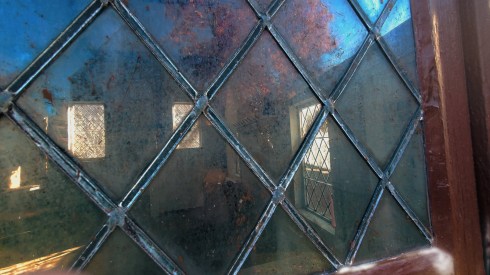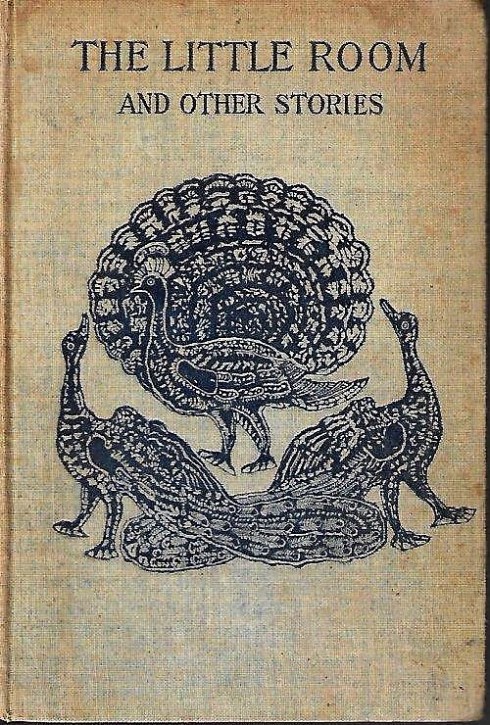Every old house has secrets, but every old house does not have deliberately-constructed secretive places for hiding or hidden means of conveyence: such spaces are special. Novelists love secret staircases, and historians do too: they are evidence of intent. Well, I think everyone is fascinated by secret spaces in general: I have been since I was a child and my mother told me all about priest holes in England and that was that. When I was older and in England I was determined to find as many as I could, armed with the books below. When I was older still, and looking at the house I now live in, its owners (who were also realtors) showed me its two secret spaces: a door hidden in the master bedroom closet that opens up into the in-law apartment next door and a tunnel in the basement that opens up under the street. There’s a big door, with a big lock, leading to some underground space! I always call it a tunnel but I’m not sure how far it goes under Chestnut Street: as soon as the previous owners opened up the door and I saw black I ran upstairs! Twenty years later, I still haven’t been in that space: it’s too scary. I can assure you, however, that my husband and every single contractor who has worked in this house has been in there—they all seem to think it’s some sort of large coal bin but of course the previous owners told me it was a stop on the Underground Railroad. I have a theory that it might have been a space to store rum, as the man who built my house was Salem’s biggest distiller and he lived right across the street, but I’ve yet to find proof. So all of this is just an introduction to say: I’m interested in secret spaces! (And I was a Nancy Drew fan too and the Hidden Staircase is my favorite.)



I think that the American equivalent of priest holes are secret staircases and one of the most important secret staircases in America is right here in Salem, at the House of the Seven Gables. For generations of children in our region and beyond, myself included, the first impression or memory of the Gables is undoubtedly of the secret staircase: every child (and many adults) that I have taken to the Gables has been struck by both the idea and the experience of the secret staircase. Its aura is very interesting because it is a twentieth-century installation rather than an original feature of this seventeenth-century house. The House of Gables Settlement Association’s founder, Caroline Osgood Emmerton, and her architect James Everett Chandler, were “inspired” by Nathaniel Hawthorne’s novel in their restoration of the house: and so it acquired four more gables, a rebuilt central chimney, a second-story overhang, and a cent shop as well as additional room for the companion settlement mission. I love the headline for this Boston Sunday Globe article from January 1910: all is revealed!

The house also acquired a secret staircase, right alongside the new chimney, even though there is no secret staircase in The House of the Seven Gables. So why? There are several reasons. The house’s previous owner, Henry Upton, maintained that there had been a secret staircase and so Emmerton believed that she was putting something back that had been there before. She also believed, apparently, that the novel needed a secret staircase and so she was giving the house one: “For it seems to be that we feel the absence of the secret staircase in the story just as we feel the absence of a bit of a picture-puzzle that has been lost and has left an unfiled place in the picture.” [The Chronicles of Three Old Houses,1935]. This seems like a bit of a rationalization to me, so I’m wondering if she merely wanted a secret staircase in the house to increase its allure: such discoveries made headlines in those days and they still do.


Boston Evening Transcript 8.5.1911 (not the word “museumized”!); the era of secret staircases: that found in Governor Tilden’s Gramercy Park mansion made national headlines in 1905.
And once the secret staircase was there, it took on a life of its own. I’m working on an article on the Colonial Revival in Salem, and just read a wonderful study on interpretation at the House of the Seven Gables over the last century, based on a succession of scripts [Tami Christopher, “The House of the Seven Gables. A House Museum’s Adaptation to Changing Societal Expectations since 1910,” in Amy K. Levin, ed., Defining Memory: Local Museums and the Construction of History in America’s Changing Communities (2007); the chapter on the Gables in Colin Dickey’s Ghostland is great too.]. In the beginning, the staircase was explained in terms of smuggling/tax evasion or “a means of escape in witchcraft times.” Then there was a shift to the Underground Railroad, and finally an admission of its 20th century origins. The staircase has reflected historical interests, and historical inquiry over time, but it has also been a means to express simple (childhood) curiosity, and there’s nothing wrong with that.


Early twentieth-century postcard and the secret staircase in 1950 (National Geographic) and today (or recently).




 The Narbonne House of the Salem Maritime National Historic Site; John Ward and Crowninshield-Bently Houses, Peabody Essex Museum.
The Narbonne House of the Salem Maritime National Historic Site; John Ward and Crowninshield-Bently Houses, Peabody Essex Museum. Window of Quaker Meeting House, Salem, Peabody Essex Museum.
Window of Quaker Meeting House, Salem, Peabody Essex Museum.













































 Two prints by Moseley Isaac Danforth based on a painting by Charles Robert Leslie, 1837, British Museum and Pennsylvania Academy of the Arts.
Two prints by Moseley Isaac Danforth based on a painting by Charles Robert Leslie, 1837, British Museum and Pennsylvania Academy of the Arts. 



 Postcards from the 1930s-1950s of the Arbella and what was originally called The Pioneer’s Village at the time, including a very healthy-looking Lady Arbella in front of “her” house.
Postcards from the 1930s-1950s of the Arbella and what was originally called The Pioneer’s Village at the time, including a very healthy-looking Lady Arbella in front of “her” house.









 The Sensational Sidney brothers as boys: Sir Philip and Sir Robert, from a painting by Mark Garrard at the Sidney’s ancestral home Penshurst Palace, Kent.
The Sensational Sidney brothers as boys: Sir Philip and Sir Robert, from a painting by Mark Garrard at the Sidney’s ancestral home Penshurst Palace, Kent.
 Sir Philip Sidney, 1577-78, courtesy the Marquess of Bath, Longleat House; A trio of Sidney copied portraits from the sixteenth, eighteenth, and twentieth centuries: National Portrait Gallery, London; an 18th century copy, NPG, London, and a 20th century version attributed to Frederick Hawkesworth Sinclair, Pembroke College, Oxford University.
Sir Philip Sidney, 1577-78, courtesy the Marquess of Bath, Longleat House; A trio of Sidney copied portraits from the sixteenth, eighteenth, and twentieth centuries: National Portrait Gallery, London; an 18th century copy, NPG, London, and a 20th century version attributed to Frederick Hawkesworth Sinclair, Pembroke College, Oxford University.


 Sir Philip Sidney, early 17th century, National Trust @Knole; by John de Critz the Elder, c. 1620; by John de Critz the Elder, 17th century; by George Knapton, 1739.
Sir Philip Sidney, early 17th century, National Trust @Knole; by John de Critz the Elder, c. 1620; by John de Critz the Elder, 17th century; by George Knapton, 1739.
 1931 Cheshire House edition with illustrations by Abner Epstein; 1950 British film version.
1931 Cheshire House edition with illustrations by Abner Epstein; 1950 British film version.




 The house exterior in the 1928 American film, the 1950 British Film, and the 1960 Roger Corman film; Jean Epstein’s 1928 film prefers to focus on its baronial interior.
The house exterior in the 1928 American film, the 1950 British Film, and the 1960 Roger Corman film; Jean Epstein’s 1928 film prefers to focus on its baronial interior.


 The House: illustrations by Robert Swain Gifford (1884); Daniel Walper (1922), Albert Dubout (1948), Arthur Rackham (1935) and Gris Grimly (2004).
The House: illustrations by Robert Swain Gifford (1884); Daniel Walper (1922), Albert Dubout (1948), Arthur Rackham (1935) and Gris Grimly (2004). Confronting a GEORGIAN haunted house: The Little Stranger (2018). Talk about a house-centered story! In both the film and the book, the house is a MAJOR character, even more so than in Usher. The juxtaposition of the airy (though decayed) Georgian and the “presence” heightens the tension, and you realize that possession has multiple meanings.
Confronting a GEORGIAN haunted house: The Little Stranger (2018). Talk about a house-centered story! In both the film and the book, the house is a MAJOR character, even more so than in Usher. The juxtaposition of the airy (though decayed) Georgian and the “presence” heightens the tension, and you realize that possession has multiple meanings.






 Mary Ann Wilson, Young Woman Wearing a Turban, c. 1800-1825, Museum of Fine Arts, Boston; Portrait of a “fashionable” woman, c. 1810, Northeast Auctions; Hepzibah and her turban (or turbans, as they all seem to be different styles) by Maude and Genevieve Cowles (1899), A.A. Dixon (1903) and Helen Mason Grose (1924), and a more recent (1997) Classics Illustrated cover depicting a very grim turban-wearing woman indeed.
Mary Ann Wilson, Young Woman Wearing a Turban, c. 1800-1825, Museum of Fine Arts, Boston; Portrait of a “fashionable” woman, c. 1810, Northeast Auctions; Hepzibah and her turban (or turbans, as they all seem to be different styles) by Maude and Genevieve Cowles (1899), A.A. Dixon (1903) and Helen Mason Grose (1924), and a more recent (1997) Classics Illustrated cover depicting a very grim turban-wearing woman indeed.

 Photograph of Dolley Madison by Mathew Brady, 1848, Library of Congress; Painting by William S. Elwell, also 1848, National Portrait Gallery. Dolley descends upon the White House and witnesses her husband’s presidential oath, be-turbaned of course, in two YA books, Dolley Madison, First Lady, by Arden Davis Melick (with illustrations by Ronald Dorfman), 1970 & Dolly Madison, Famous First Lady, by Mary R. Davidson (with illustrations by Erica Merkling), 1992.
Photograph of Dolley Madison by Mathew Brady, 1848, Library of Congress; Painting by William S. Elwell, also 1848, National Portrait Gallery. Dolley descends upon the White House and witnesses her husband’s presidential oath, be-turbaned of course, in two YA books, Dolley Madison, First Lady, by Arden Davis Melick (with illustrations by Ronald Dorfman), 1970 & Dolly Madison, Famous First Lady, by Mary R. Davidson (with illustrations by Erica Merkling), 1992.


